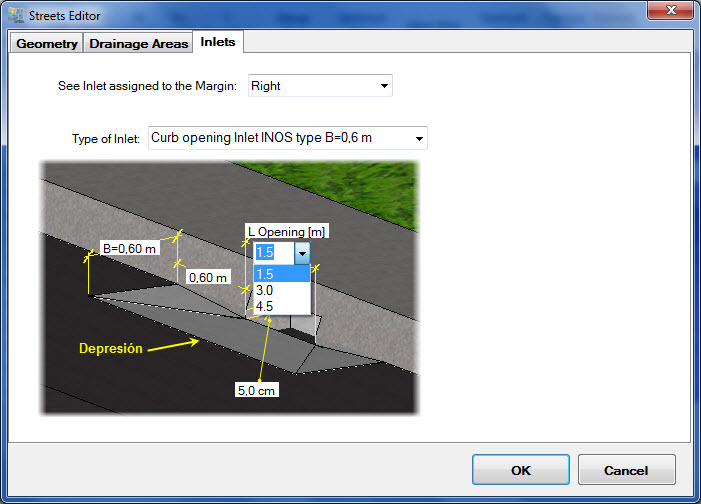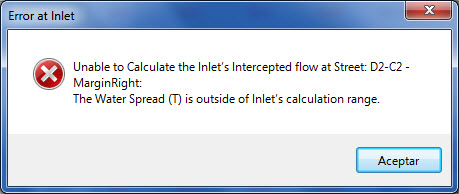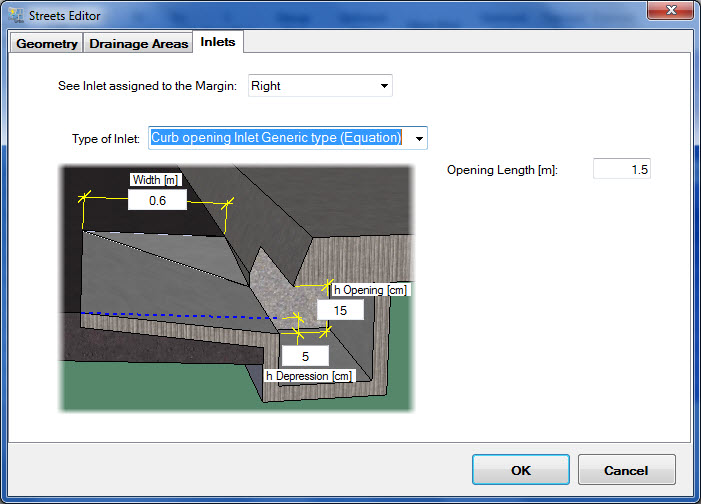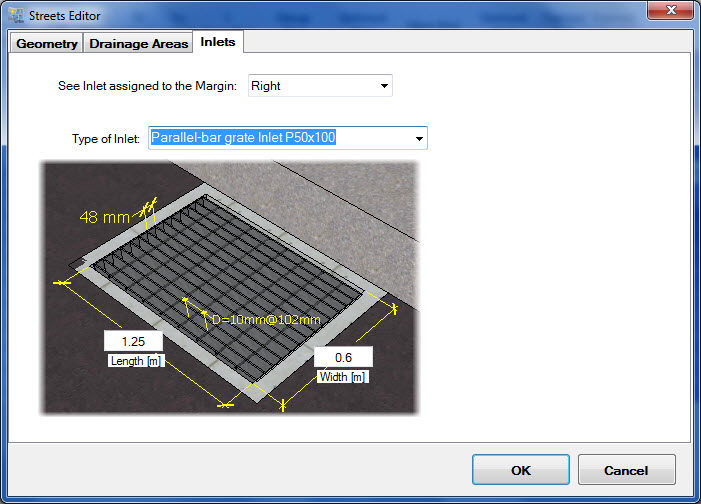This tutorial is for the interface and features of Version 1.1 of DREN-URBA.
With the release of Version 2.0 in November 2015, some features have been modified, as you will see in the corresponding tutorials.
One of the advantages of DREN-URBA, our Stormwater Drainage Design Software, is the incorporation of a library with different types of Storm Drain Inlets, so that the design engineer only has to select the one that best suits the particular conditions of each design.
For those who have made the manual calculation of stormwater collection systems in Urban Drainage, it is known that the procedure generally involves using design charts or graphics in which the drain inlet’s intercepted flow is determined based on parameters such as the total flood spread or the average height of water in the approach to that inlet.
This ‘manual’ approach, although it is not extremely complicated, is subject to various drawbacks, some of which are:
- Error in the appreciation of the design chart’s values, caused by bad axis scaling or, simply, problems in the visual capacity of the personnel that use them.
- Need to repeatedly resort to those design charts when modifications in the hydraulic parameters – used for the determination of the Inlet’s Intercepted flow – changes. For example: as the Rainfall Intensity changes, the Inlet’s approaching flow will also change, so the engineer will be required to resort to the design chart in order to calculate a new intercepted flow.
With DREN-URBA, these drawbacks are largely resolved because the routines to obtain values of the Inlet’s intercepted flow automatically have been implemented on it, from the calculated information for the margin of the street in which the catchment element is located.
Let’s review below the storm drain inlets that are incorporated in the current version (1.1) of DREN-URBA, with their respective features:
Stormwater Catchment with Curb-opening Inlets in DREN-URBA

The curb-opening drain inlet operation depends on, in addition to parameters such as longitudinal and cross slopes of the street on which it is located, the geometrical characteristics of the Depression that is usually built to improve its efficiency in the stormwater collection.
Thus, it will be possible to select two types of curb-opening drain inlets from DREN-URBA:
INOS Type Curb-opening Inlet
This is the ‘Standard’ curb-opening inlet used in Venezuela and it has been incorporated in DREN-URBA with two variants: for depression widths of 0,6 and 0,3 m.
The selection of this type of drain inlet is based on design curves developed for different opening lengths: 1,5 m, 3,0 m and 4,5 m, and that is why this is the only parameter that can be changed when you select this type of drain inlet from the Street’s Editor →Inlets tab:

- The flow’s width spread, on the approach to the drain inlet, is between 1 and 3 m.
- The street’s cross slope, on which the drain inlet is placed, must be between 1,5 and 6%
- The street’s longitudinal slope, on which the drain inlet is placed, must be between 0,2 and 4%
In the case that any of these conditions are not fulfilled, DREN-URBA will show a warning message, informing you that the drain inlet is out of its type’s application limits, interrupting the calculation:

Generic Type Curb-opening Inlet
The possibility of determining the intercepted flow captured by “Generic” curb-opening inlet has been further incorporated, in which the user can specify the geometry of the inlet’s depression as well as the curb-opening:

Thus, according to the specified parameters for the drain inlet by the user, DREN-URBA will calculate its efficiency according to the specified length and the total length (LT) required to capture 100% of the approaching stormwater flow (Q) to the inlet:

Where So and Se are the street’s longitudinal and cross slopes, respectively.
Stormwater Catchment with Grate Inlets in DREN-URBA
A storm grate inlet consists of an opening in the gutter covered by a grate conformed by metallic bars that, ideally, should be oriented in parallel to the flow direction but, to facilitate the structural strength and the bicycle traffic, are usually placed inclined in a manner similar to that shown in the next figure:

In DREN-URBA two types of storm grate Inlets have been incorporated:
Storm Grate Inlet with Bars Parallel to the Flow Direction
In this group of stormwater collection elements have been included in two classes:
- P-50 Parallel bar Grate Inlet. This, used in North America, consists of a grate with bars parallel to the flow direction and bar spaced at a distance of 48 mm on center. Its standard dimensions are: 0.60 m wide and 1.25 m long, but it is possible to modify these values in DREN-URBA:

- P-50×100 Parallel bar Grate Inlet. The fundamental difference of this type of inlet from the previous one is that circular bars of 10 mm diameter are arranged transversely and spaced at 102 mm on center:

Storm Tilt-bar Grate Inlet – (INOS type)
The INOS type Tilt-bar grate inlets are, once more, the standard inlets used in Venezuela and consist of a grate in which the bars are arranged inclined to the direction of flow. The separation between bars is 60 mm, and the inlet’s standard dimensions: 1.50 m wide and 0.90 m long:

In this case, DREN-URBA considers that the grate inlet may be placed in two arrangements: Normal, in which case the width is 1.5 m (above image) and Aligned, where its position is modified so that the short side of the opening rectangle (0.90 m) will be the width of the inlet.
Similarly to the INOS type curb-opening inlets, the grate inlets operational range has its limits:
- The street’s longitudinal slope on which the grate inlet is placed must be between 0,1 and 10%
- The approach stormwater flood height in the grate inlet is greater than 3 cm.
In any case, if these conditions are not fulfilled when using this storm drain inlet, DREN-URBA will show the respective message to inform the user about the situation.
Thus, you can see that our Stormwater Drainage Design Software has several types of drain inlets that can be used in your designs. The incorporation of any of these types of inlets in your project is as simple as going to the Inlets tab in the Street’s Editor Dialog and selecting the margin of the street where it will be located and choosing the storm drain inlet from the list.
The rest? Leave it to DREN-URBA!


